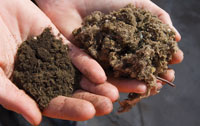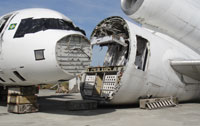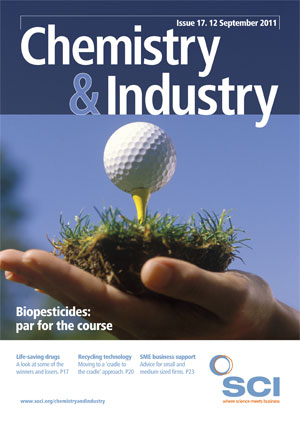A major objective behind recycling – in addition to the primary aim of protecting the environment – is to breakdown end-of-life-products into their original raw materials or even into the molecules of their component parts so that they can be reused in the manufacture of new products. The long-term goal of this ‘cradle to cradle’ (C2C) approach is to make recycling a prime alternative source of valuable raw materials. This will require new and improved recycling technologies. As a result there will be opportunities for companies, like waste management and recycling specialists, to establish themselves as operators using new, often chemistry-based, technologies.
European interest
The importance of new recycling technologies is highlighted in a proposed project on resource efficiency currently being assessed by the European Commission for inclusion in the European Union’s next seven-year research programme, Horizon 2020, which starts in 2013. Observers suggest that if, as seems likely, the project, Sustainable Process Industry (SPI), goes ahead, it could attract funds of €1–2bn.

‘Around 1.7bn t of waste are incinerated or land-filled each year among the EU’s 27 member states,’ explains Ed d’Hooghe, who is responsible for running the innovation activities of the resource efficiency PPP at the European Chemical Industry Council (Cefic). ‘If we could tap into the potential of that huge resource in a bigger way it would do a lot to alleviate the pressure on raw materials with limited resources. Instead of relying on mechanical recycling we need to do much more breaking down of used materials like plastics into their original molecules for reuse in new products. Only a small proportion of materials are reused in this way,’ he adds.
The PPP scheme will face numerous challenges in its efforts to find new methods of giving value to waste. For example, ways have to be discovered for reusing waste streams within and outside supply chains – examples include using biowaste from food in other sectors and using precious metals and high-value chemicals from electronic equipment in other industries.
However, in the drive to establish recycling as a source of raw materials, governments and industries will have to ensure that the environmental impact on the rest of a product’s life cycle is not forgotten. A balance needs to be achieved between the sustainability of recycling and the use phase of products.
‘The so-called “cradle-to-cradle” philosophy highlights the need to eliminate waste and aims to make production eco-friendly,’ says Andreas Kicherer, BASF’s head of marketing and sales sustainability. ‘BASF supports these goals and sees them as part of its corporate strategy to ensure sustainable development. But the C2C concept is very much focused on recycling and lacks, in our view, a comprehensive and balanced assessment of sustainability along the entire life cycle of a product system,’ he adds.
According to Kicherer, the environmental benefits of different recovery methods are generally insignificant. With plastics, for example, the environmental impacts of recycling, as well as of the production of materials, are negligible when compared with the impact of the consumer use phase, he says. ‘Design for recycling is not an end in itself,’ he explains. ‘The environmental impact of products should be minimised over the entire life cycle.’
Recyclers will have to take care that new recycling technologies meet sustainability criteria. ‘We must not allow recycling to lead to unnecessary energy consumption, thereby increasing CO2 emissions,’ says Arie de Jong, chief executive of Auto Recycling Nederland (ARN), one of Europe’s leading specialists in automobile recycling. ARN, which co-ordinates the Netherlands’ national auto recycling chain of dismantlers and shredders, has developed an Ecotest for measuring the carbon footprint of its chain and for performing life cycle assessments (LCAs) of the recycling process. Recycling technologies will be judged not only on the basis of their sustainability but also on their capabilities to keep up with changes along the supply chain. These include the introduction of new materials in the manufacture of products, often to improve their own sustainability, but also the effects of new fears about safety.
Phosphorus and paper
New methods for recycling phosphorus in the agriculture, food and other sectors are being developed because of worries about the health and environmental hazards of the current practice of spreading sewage sludge containing phosphorus onto farm land. Sewage sludge also contains heavy metals, pathogens and other toxic substances.
There is the added threat that the global reserves of phosphate rock, which lie predominantly in China, Morocco, Jordan and South Africa, will run out in 70 years at current rates of consumption.
Thermphos International of the Netherlands, one of the world’s largest manufacturers of phosphorus-containing products, has recently switched a high proportion of its output to phosphorus extracted from the ash of sewage sludge, as well as from bone meal and manure. And Outotec in Finland, a leading provider of technologies to the mining and metallurgical industries, expanded this year into phosphorus recycling by taking over Ash Dec of Austria. The Austrian company developed a thermal decontamination process for recovering phosphorus from sludge ash and Outotec aims to extend this process to recover phosphates from manure and chicken litter, and from residues of anaerobic digestion and slaughterhouses.
Safety concerns about current methods of paper recycling may also necessitate improvements. Carcinogenic mineral oils have been detected in foods packaged with recycled paper products, for which much of the blame has been put on newspaper and magazine inks. In response, some consumer brand owners in Europe have instructed suppliers to use only paper and board packaging made from virgin paper. The German government has already drawn up draft legislation, laying down strict controls on the mineral oil content of paper packaging materials. In the absence of regulatory action by the European Commission, other EU national governments may follow the German example.
The development and introduction of improved technologies for recycling paper, which accounts for 65% of paper consumption in Europe, would be a huge and costly exercise. The Confederation of European Paper Industries (CEPI) suggests that a more practical and less expensive solution may be the reformulation of inks, even though some research shows that all the mineral oils found in packaged food do not come only from inks but also from other sources such as printing and processing machinery.
Cars, planes and gadgets
In the automobile sector, recycling organisations are striving to recover a higher proportion of reused materials from vehicles with existing technologies. At the same time they have to adapt to new materials being used by manufacturers to reduce the weight of vehicles, increase fuel efficiency and make cars electronically smarter.

ARN runs one of the most advanced car recycling schemes in Europe, and has recently opened a post-shredder technology (PST) plant. Currently a lot of the shredder residue from cars is incinerated or put into landfill. The PST units are equipped to break down plastic residues into reusable materials. This will help ARN meet the 2015 ELV target.
ARN is also investing in R&D into the recycling of new materials in cars in collaborations with various institutes, including the Netherlands Organisation for Applied Scientific Research (TNO) and the technical universities of Delft and Eindhoven. ‘Over the coming years, funding will be needed for research into the consequences for recycling of new technologies that are being introduced in cars,’ says ARN’s de Jong. ‘This, for example, includes the processing of high-voltage batteries from electrical vehicles and the composite materials that are increasingly used in cars.’
A major technological task will be the handling of carbon fibre composites, which are increasingly being applied to cars to lower their weight. The fibres, which are virtually indestructible, will be difficult to recover from complex composite materials.
This is also a problem facing the aviation industry, which is replacing aluminium and other metals in aeroplanes with carbon fibre composites. Although the first planes to use large quantities of carbon fibres, like Boeing’s 787 Dreamliner, will not come out of service for 30–40 years, the sector is already developing technologies to deal with composites.
Boeing and Airbus, both major manufacturers of commercial aeroplanes, have set up organisations and infrastructures for aircraft recycling. Airbus introduced PAMELA – a process for advanced management of end-of-life aircraft – while Boeing helped found the Aircraft Fleet Recycling Association (AFRA) in 2006.
With around 50 member companies globally, AFRA now recycles around 150 commercial planes each year with mostly components, aluminium and other metals being recovered. By 2016, AFRA expects to raise the rate of recycling of materials from the current 70% to 90–95%. ‘Partnerships such as AFRA create innovative models which accelerate technology development,’ Jeanne Yu, Boeing’s director for environmental performance, told a recent AFRA conference.
Boeing is also collaborating with Milled Carbon of the UK and Adherent Technologies of the US to develop new technologies for recycling carbon fibre and other composites. Milled Carbon has developed a pyrolytic continuous flow process for burning off resins and additives around carbon fibres. Adherent Technologies applies a low-temperature catalytic conversion process to break down carbon fibre composites and complex thermoplastic and thermoset composites. In the electrical and electronic sectors, chemical companies, such as Rhodia and BASF, have introduced or are developing technologies for the recovery and reuse of rare earths in appliances, which, despite being worth up to $800/kg, are being sent to landfill for disposal. Rhodia, for example, already has a solvent-based technology for separating and reusing rare earths from low-energy light bulbs, and is collaborating with the materials technology group Umicore to develop a process for recycling rare earths from nickel metal hydride (NiMH) rechargeable batteries.
Coolrec, a subsidiary of the Dutch recycling group Van Gansewinkel and a leading European recycler of electronic and electrical equipment, has developed a method for processing and recycling flatscreen TVs containing rare materials, like indium. Van Gansewinkel is also involved in a public–private research consortium that is looking to recycle electronic equipment within closed loop systems. Its members include Philips, Nitto Denko of Japan and Umicore.
While Europe, North America and Japan focus on the challenges posed by the recycling of new technological equipment, much of the rest of the world is still struggling to achieve minimal levels of recycling of products that have been on the global market for decades. There is still a lot of work to be done in recycling in both the developed and developing worlds.





